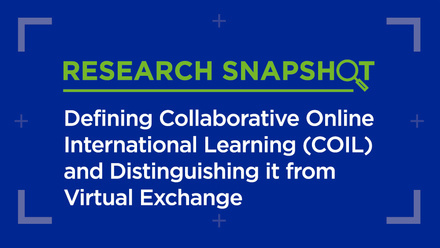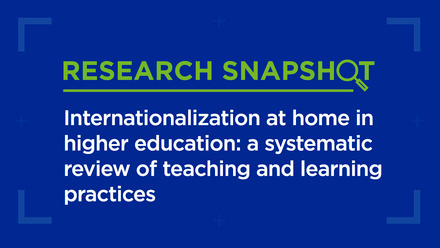Virtual collaboration for international learning

Rapid technological developments are changing the way most of us work. We check our apps every day, we log in to our computers from home and we meet colleagues, share documents and sometimes work on whole projects in the virtual world. But how can we prepare our students to deal with this?
In a collaborative project, The Hague University of Applied Sciences and Zurich University of Applied Sciences used a Collaborative Online International Learning (COIL) format – a teaching and learning methodology based on collaborative and blended learning – to encourage students to research virtual cooperation while also actively experiencing it for themselves.
Setting up
The project involved four groups, each featuring a mix of four to five students from the two universities, two lecturers from each university and one e-learning expert from Zurich. It ran from September to December 2018, kicking off in The Hague and rounding off in Zurich. The start and end points were the only live contact moments, with the rest of the work done collaboratively online. Each group was given one of the following challenges that are often considered inherent to virtual collaboration, as suggested by Harvard Business Review:
- You must set and manage expectations more proactively, partly because of cultural and language issues.
- You are your own IT department and must deal with technological challenges yourself.
- You have to spend too much time building and maintaining relationships because of the lack of face-to-face contact.
- Other people cannot ‘see’ your work.
Getting started
Kick-off took place in The Hague over two days. Dutch cultural activities and a dinner were combined with a formal programme to introduce the topic and get students started on their plans of approach. Participants were also given an introduction to different tools for collaborative learning.
Once they were all set up and ready to start collaborating virtually, students ran into their first technological issues. As one Swiss participant put it: “We were very enthusiastic about trying out and getting to know new tools for collaboration. Our goal was to open our horizons and use MS Teams, Slack, Whiteboard, etc. We failed with MS Teams. We weren’t able to work with Word Online and for some unknown reason we had to open MS Word differently.”
A Dutch student, meanwhile, reported difficulties in adjusting to online communication: “I have to get used to the virtual collaboration. Online interaction is way different than face-to-face communication. First of all, when using the group chat you should really think about how you write things down. It’s not the same as talking face-to-face to your team member.”
Finding the right tools
The research was divided into several parts: desk research, a midway presentation, interviews with experts and then a conclusion. An online tool called Padlet was used to keep an overview of the collaboration, with all students posting their progress and lecturers providing assignments and extra information where needed. This was a handy arrangement and much easier in terms of access than using a classic format such as a blackboard.
“Sometimes we talk at the same time and don’t hear what the other person is saying. You should really feel it when it’s your time to talk.”
Within the groups, students were free to choose which tools to use for different purposes. “We share our information and documents on OneDrive,” said one Dutch student. “Next to this, we use OneNote to brainstorm and share notes and important links. We use Teamup Calendar for our deadlines but also for our personal agenda, so everyone knows about your personal deadlines and when you have no time or a lot of time.”
Another Dutch student reported: “We use Zoom as our virtual meeting room. The challenge is to let other people talk. Sometimes we talk at the same time and don’t understand or hear what the other person is saying. You should really feel it when it’s your time to talk.”
Coaching and reflecting
To monitor progress between the research phases, we asked students to make group appointments with both a Dutch and a Swiss lecturer online, mostly through Skype or Zoom. It was agreed that halfway through the project, online presentations would take place. Students logged in to Zoom and each group presented its progress to the other groups and lecturers.
This mid-term presentation was “a nice way to talk about the results because the setting was different”, one Swiss student said. “We heard each other present it instead of the simple writing and reading. I think this had a positive influence on the rest of our work.”
Students also reflected on each individual research phase through Edublogs. This allowed coaches to talk to students in a group setting about the content of the research and also to monitor individual perceptions. The Edublogs were only shared with the coaches and for each research phase students were given a set of questions to choose from to allow more in-depth reflection. The quotes in this article are taken directly from the Edublogs, with permission, but made anonymous.
Finishing the project
The project came to a close in Zurich. The students handed in their reports on Padlet a week earlier and were then asked to make a digital poster and a video about their research. This not only ensured that all information was digitally available but also that the content was more engaging than just a report or a PowerPoint presentation would have been.
The students discovered big differences between virtual and face-to-face collaboration. As their main research outcomes, they identified that practitioners of virtual collaboration needed to realise these differences and do the following:
- Be explicit in their expectations.
- Have some training in IT to enable digital flexibility.
- Focus on relationships rather than only on the project.
- Build trust by showing their capabilities where appropriate.
“Throughout the course of the project, we have learned how to collaborate more and more effectively and we have developed a structure that helps us to work efficiently,” said one Swiss student. “We were able to improve our skills in virtual communication. We have become accustomed to talking via Skype and WhatsApp. We have a good rhythm in which we exchange information via video conferencing.”
But students learned much more than just how to improve their virtual communication. They learned about themselves, about each other’s culture and about different methods of study. As one Dutch student concluded: “I made new friends, I had a lovely time and I am one step further in collaborating. I know a lot more about virtual tools and collaboration, I know more about myself, and I think my English speaking and writing have become more fluent.”






